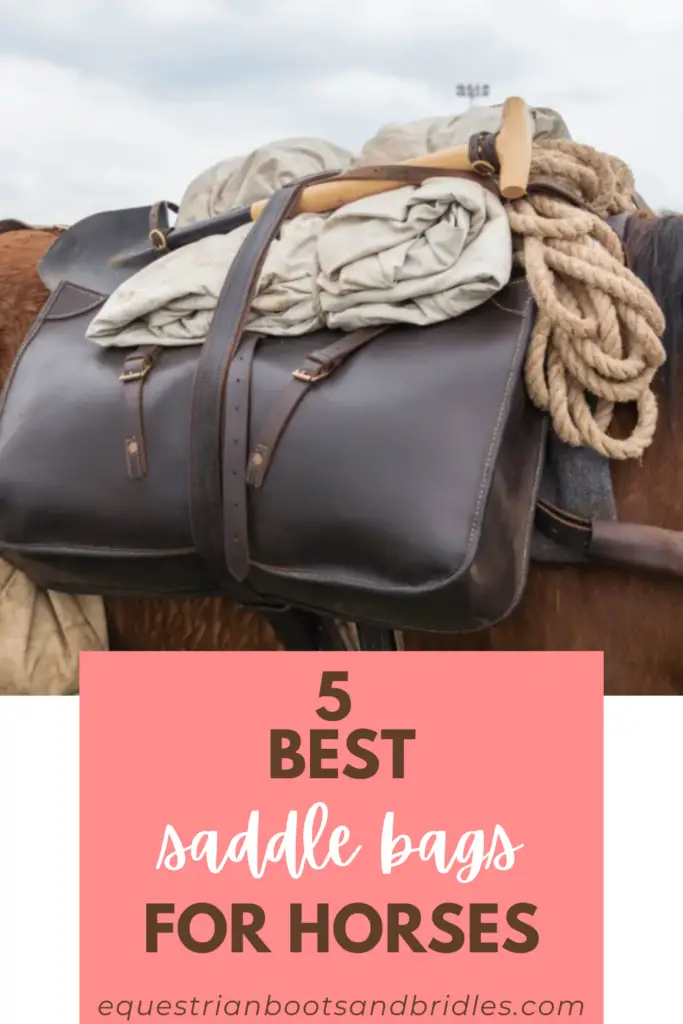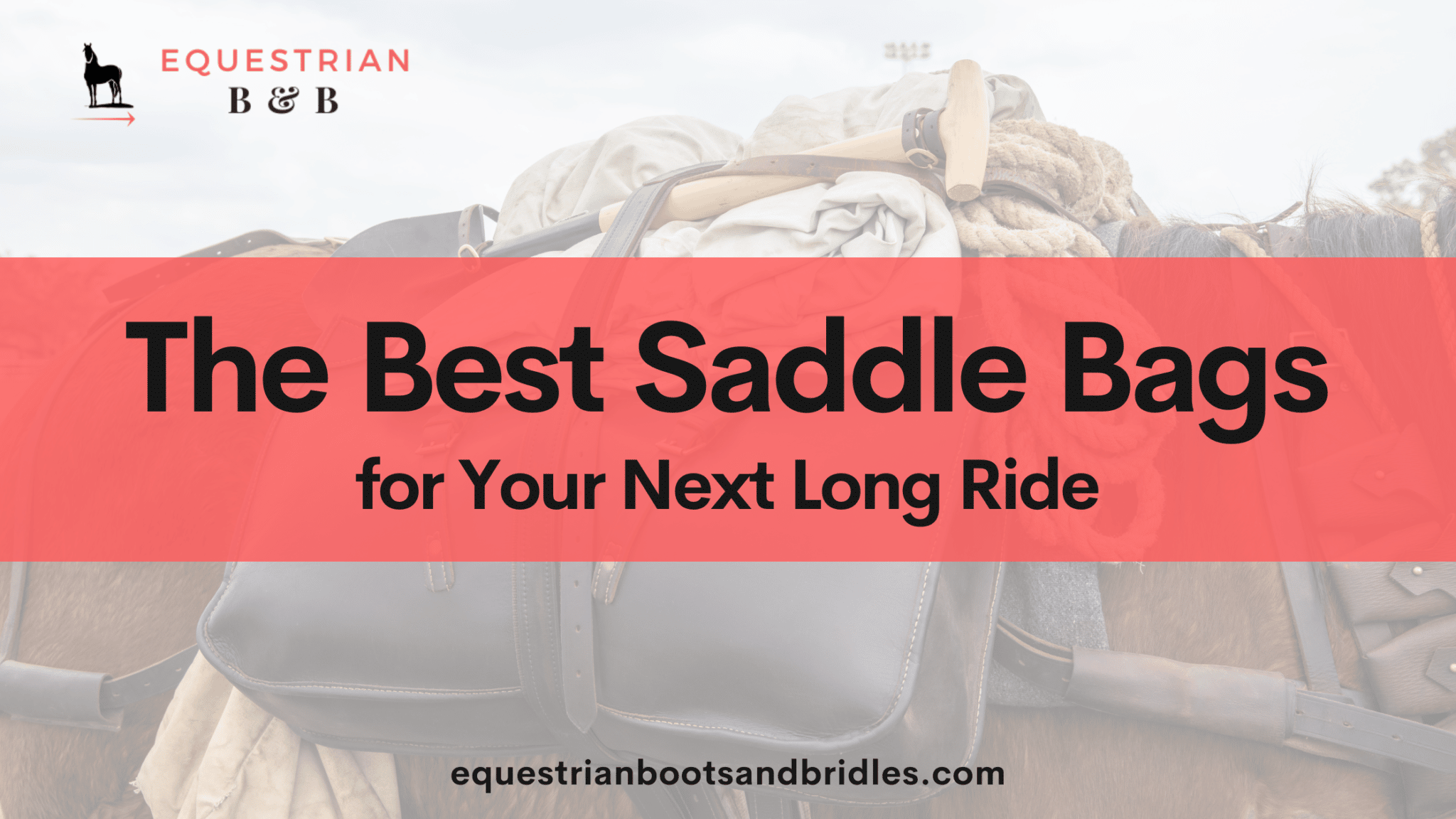If you’ve never ridden a long distance on horseback, you’d be forgiven for not knowing what a horse saddle bag is. However, horse saddle bags are still functional today (despite their historical origins), and today some are even decorative.
Knowing which is the best horse saddle bag for you will depend on what type of riding you do and your riding equipment.
So this article will tell you what to consider in choosing your saddle bag and then I’ll give you my recommendations.
This article contains affiliate links, which means we may earn a commission if you decide to make a purchase.
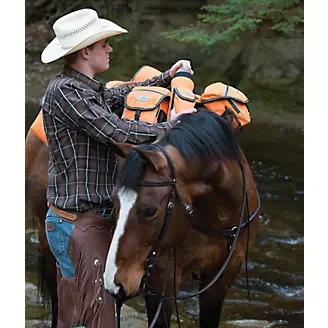
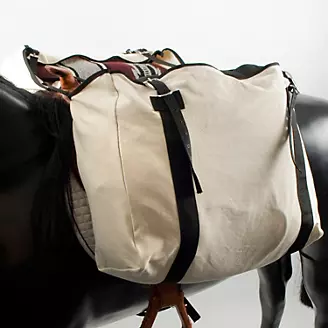
What Is a Horse Saddle Bag?
A horse saddle bag, like the name suggests, is a bag that fits loosely over the barrel of the horse, attached to the back of the saddle. Saddle bags were traditionally used by riders who traveled far to keep their provisions and a change of clothing in.
Saddle bags are made from a range of materials, come in different sizes, and have several ways they are fastened to the saddle. Knowing what you’d prefer depends on what you store in your saddlebags (and how much you need to carry), as well as the size of your horse.
The type of saddle you ride in will also influence the type of saddlebags you can use. A Western saddle bag won’t look as good when paired with an English saddle!
If you do trail riding, endurance riding, or ranch work, a good saddle bag is indispensable.
What Makes a Great Saddle Bag?
A great saddle bag is elegant in design, keeping function in mind and balancing that with practical application. You want a saddle bag that won’t bounce around or hook on trees when riding. Likewise, you also want a saddle bag that cleans easily and dries effortlessly to ensure ultimate functionality and quality.
Investing in a good quality saddle bag will pay dividends as a saddle bag can last you a lifetime (and more).
Spoiler Alert!
If you just want a quick recommendation, the overall best horse saddle bag on the market for someone who doesn’t have a huge budget but wants quality is the Tough1 Insulated Saddle Bag. It’s great for those who want to take some trail snacks when riding or add some extra riding essentials for an all-day ride.
I’ll tell you more about this bag in a minute. But first, here are some things you might want to keep in mind as you shop:
Buyer’s Guide for Selecting the Best Horse Saddle Bags
With so many saddle bags on the market (and not all saddle bags being created equally), it can be frustrating to choose a saddle bag that suits your needs. So here’s what to look for:
Overall Quality
The saddle bag you choose should be well made. Look at stitching, mechanisms for closing, and mounting the saddle bag to your saddle. If it feels cheap, it will probably not last.
Poor quality materials will cost you more in the long run. Low-grade leather can rip or will rot quickly, while thin or poorly woven synthetic materials can rip, melt, and wear through.
The final quality check is to inspect the buckles, fasteners, and any other hardware. If it feels flimsy, it will likely disappoint you in no time at all.
Style of Horse Saddle Bag
The style you choose should match your riding purpose. If you ride in an English saddle, you probably won’t be able to add a large Western saddle bag with all the bells and whistles. However, you can add a smaller and lightweight plain leather saddle bag.
Importantly, take note of the different positions where your saddle bag straps should attach to the saddle. It’s not ideal to purchase a saddle bag where the buckles don’t line up to the dee rings on the saddle or the girth straps that prevent the saddle bag from bouncing.
If you ride over rough terrain, you also don’t want a saddle bag that won’t close properly, as half your saddle bag’s contents may end up lost along the trail!
Balance, Weight, and Size
If you are new to riding with a saddle bag, you may not yet realize why buying a balanced saddle bag is so important. For starters, a balanced saddle bag is much easier to attach to the saddle, while a large and weighty one will be a struggle when it comes to securing its contents from bouncing around at a canter or gallop.
The size of the saddle bags you choose should also be appropriate to the type of horse you have, where you ride, how long you ride, and where you ride. Large saddle bags are an integral part of trail riding gear, while shorter rides only require a smaller and lightweight set of bags.
Suitability to Your Riding
Depending on the riding you do and where you will be using your saddle bags, you need to choose a set of bags that are appropriate to your terrain, season, and equipment. If you ride in rainy weather, you would do well to invest in a weatherproof saddle bag, but if you ride in extreme heat, you would want an insulated bag with padded pockets to keep meals and tools from becoming too hot.
Cost of Saddlebags
If you only go long distance hacking once a year, you may only want to get a functional and basic set of saddlebags. After all, you’ll only be using these every once in a while, not daily. Spending hundreds of dollars on something that will hang in your tack room won’t really be wise.
However, if you are a working rider who rides daily and uses saddle bags as part of your regular tack, then a great set of saddlebags is an investment you can definitely splurge on.
5 Best Horse Saddle Bags to Consider
Saddle bags can be a real thing of beauty, and there are many to choose from. Here are my best personal options, and why you should consider them.
Best Horn Saddle Bag
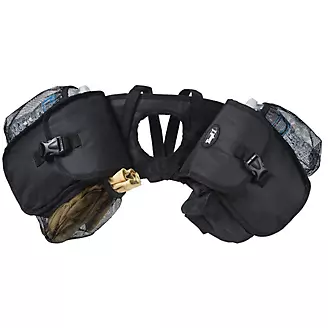
I simply love a smaller set of saddlebags that fit over the horn of my Western saddle. The Tough1 Elite Insulated Horn Bag is ideal for carrying tools, water bottles, and more—all within easy reach. The snag is, these bags only work for Western saddles that are fitted with a horn, as regular or English saddle pommels won’t carry these as well.
Pros
- Compact and easy to fit
- Ideal for those involved in search and rescue across rough terrain
- Robust design that won’t catch on brush or tangle
- Holds three water bottles in mesh pockets
- Quick clip buckles secure the outside flaps
- Great price at $39.88
Cons
- Velcro straps secure the bag to the saddle horn, but not all riders may know how to correctly secure the bags
Best Synthetic Narrow Saddle Bags
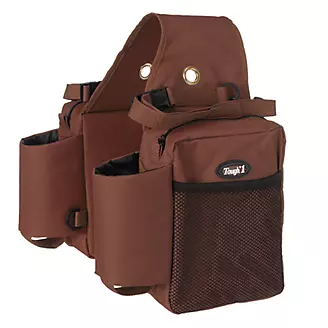
The Tough1 Insulated Saddle Bag is ideal for short-backed horses or for short rides across terrain where you’d prefer to keep your saddle bags in close contact with your horse. The insulated padded pockets are ideal for keeping water bottles cool and secured.
Pros
- Add rain gear or bed rolls over the back with adjustable straps
- Heavy denier fabric that is rip-resistant
- Mesh pockets for adding smaller items like snack bags etc.
- Fair price at $35.88
Cons
- The pockets for water bottles are not deep enough for large bottles and are poorly secured
Best Traditional Leather Saddle Bag
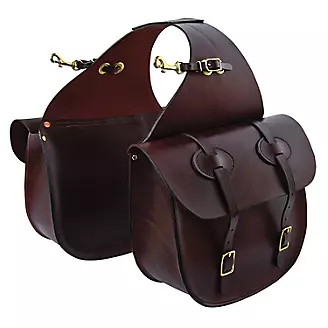
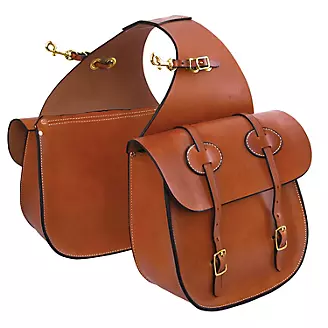
If you adore those typical Western saddle bags that you see the cowboys sling over their shoulders as they head up to the saloon, then these Tucker Traditional Saddle Bags are just for you. These bags are great quality, functional, and the epitome of Western ranch work.
Pros
- Classic “pony-express” styled design with double closures via brass-plated hardware buckles
- Cut from the same quality leather as Tucker saddles
- Quality brass plated hardware with rivets, rings, buckles, and ties
- Full gusset for expansion and to fit any riding equipment into the saddle bags
- Hand stitched finishes and assembled by hand for extra quality
Cons
- Main downer will be the price at a hefty $379.99, but this is a quality saddle bag that will last you for life
Best Medium-Budget Classic Styled Saddle Bags
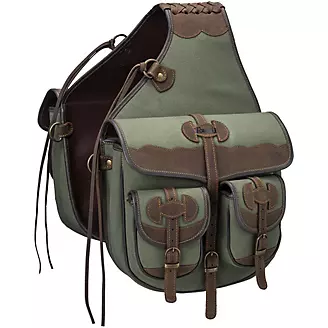
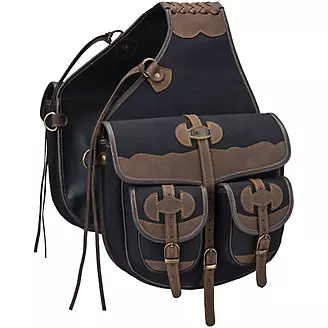
For a great quality, fine looking saddle bag that has a classic feel, you can’t go wrong with the Tough1 Canvas Trail Bag. These saddle bags are ideal for those who want a medium sized bag with a classic look, while being practical and saving on the maintenance and cost of real leather bags.
Pros
- Combination of cotton canvas and leather reinforcing
- Classic tooled finish
- Leather buckle straps are adjustable
- Synthetic backing keeps the saddle bag clean and dry of horse sweat
- Water-resistant for the occasional rain storm
- Good price at $96.88
Cons
- Small sized length of saddle bags, making it better suited to ponies
Best Shoe-String Budget Horse Saddle Bag
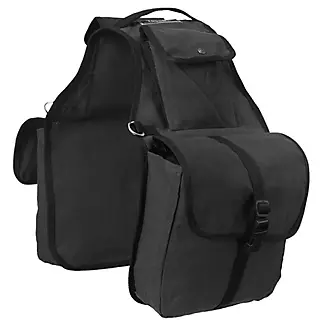
If you’re on a budget and need a functional saddle bag, the Tough1 Canvas Saddle Bag is a safe bet. This is a hardworking saddle bag, and while it won’t keep the contents dry during heavy rain, it will work hours in the sun and carry loads of tools for ranch work or nice snacks for a quick outride.
Pros
- The price at $34.31 with discounts for bulk buys
- Available in black and brown
- Made from quality canvas
- Basic dee rings for fastening to Western saddles
- Single quick release buckle per large compartment
- Double smaller bags with snap fastener to store smaller items
Cons
- Won’t fit all saddles
- Limited lifespan with heavy use
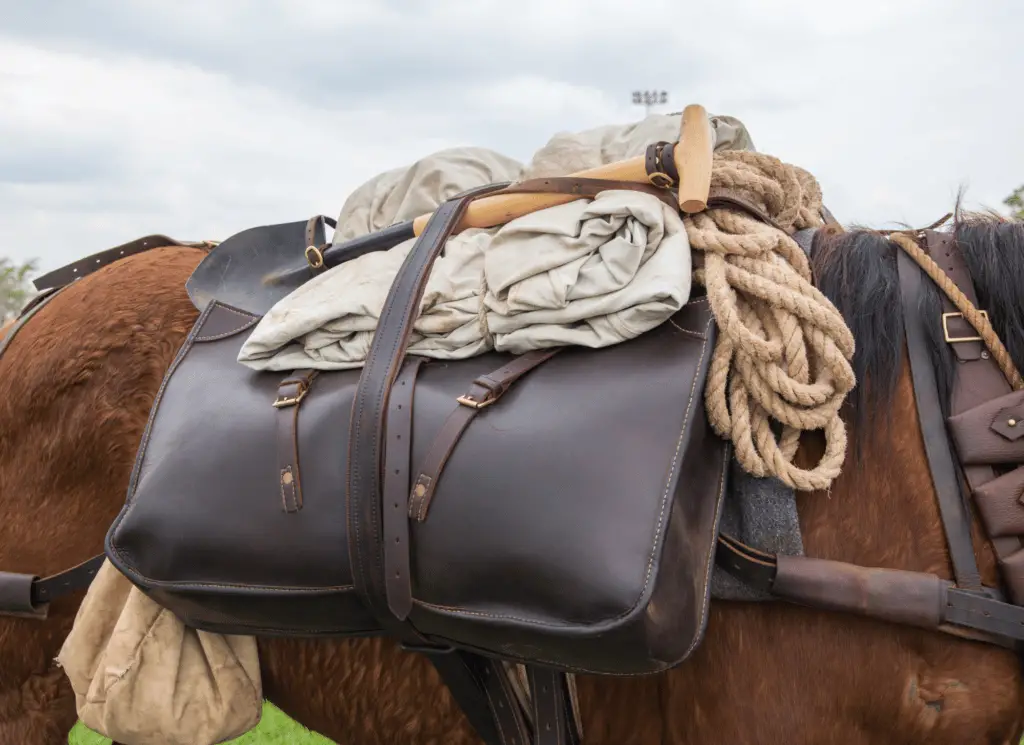
Correct Fitment for Horse Saddle Bags
You can invest in the most expensive saddle bags available, but if you don’t fit it correctly, your horse won’t thank you for them. Poorly fitted saddle bags can do significant damage to a horse’s spine, kidneys, and ribs. Luckily, it’s not rocket science.
Here’s how to fit your saddle bag correctly for your saddle and horse:
Step 1: Line Up Strings or Grommets
Your saddle bag will have strings, grommets, or clasps that attach to your saddle. When these don’t align closely, you end up with a saddle bag that slides from side to side and forward or backward across your horse’s spine. Loose and sliding equipment equals bruising, rubbing, and pain.
When you place your saddle bag in position, ensure your saddle fits closely to it. There shouldn’t be more than a quarter inch of play between the saddle bag and the saddle when fastened to minimize friction.
Step 2: Pack Your Saddle Bag Equally
Have you considered that it must feel awful to your horse when they have weight on only one side of their saddle bag? Equalize the weight of your saddle bag contents by distributing it evenly between all the pockets. The left and right side bags should weigh roughly the same.
If you don’t have enough to take with you (for example, if you’re only taking one water bottle and a snack bar for a hack), you should take something of equal weight to balance the contents. Perhaps take a second bottle or an ice brick to keep your water cold.
A good test is to place the saddle bag over your shoulder, with one side down the front and one down the back of your body. If you don’t feel like you are being pulled forward or backward, your bag is well balanced.
Step 3: Pack Kindly
When you are working with tools and need to take pliers, cutters, or more with you in your saddle bag, ensure you pack carefully. A badly placed plier can do serious damage to a horse’s sides and hip if you are inconsiderate in how you pack.
Turn all tools so their smooth sides face the inside of the saddle bag, and if possible, wrap tools in an oiled leather cloth or something similar to pad them and also protect your horse and tools.
Step 4: The Jiggle Test
If you’ve ever driven a car that squeaks, you know how annoying it can be. Likewise, a saddle that squeaks or jiggles because of a saddle bag isn’t going to be fun. Take the time to pack your saddle bags, then fasten them, and finally shake them.
Horses don’t like strange sounds or weird sensations on their skin, so ensure your saddle bags are passive passengers that won’t poke your horse, leak on them, or make a strange (and scary) noise.
Jiggling the bags vigorously will ensure you have an indication of just how much movement you can expect when you let rip on a nice canter up the road. A madly flapping saddle bag is likely to spook your horse or cause them to speed up.
Step 5: Check for Bulkiness
Your saddle bag is going to be in a position that can potentially hook your leg when mounting or dismounting your horse. If the saddle bag is bulky, chances are you will have an accident. A bulky saddle bag that sticks out far past the saddle may also get caught on branches when riding through rough scrubs.
It’s better to rearrange the contents of your saddlebags to make a more balanced and streamlined profile.
Caring for Your Horse Saddle Bags
Clean your horse saddle bags as you would your saddle and other riding equipment. Wash and air dry canvas bags when soiled, and regularly check for breaks or threads that are pulling.
Lastly, remember to check your saddle bag for burs and thorns from previous rides, as well as snakes and spiders (if it’s been in storage for more than a day or two).
The Final Pointer
Before you rush out and buy the first saddle bag you find in a local shop or online, consider what you want to store or transport in the saddle bag, as it will influence what kind of bag will work best for your riding style.
A high quality saddle bag is an investment and worth every dollar, but only so long as you care for it and keep it in top condition.
Ultimately, you want a roomy saddle bag that is durable, offers water resistance, and has several compartments that stores everything from a first aid kit to a cell phone or your lunch.
Ensure your saddle bag is kept safe and neat by storing it with the same considerations as your other riding equipment, and read my article on 6 great tack room ideas, too.
Like this post? Save it on Pinterest. Follow me on Pinterest.
